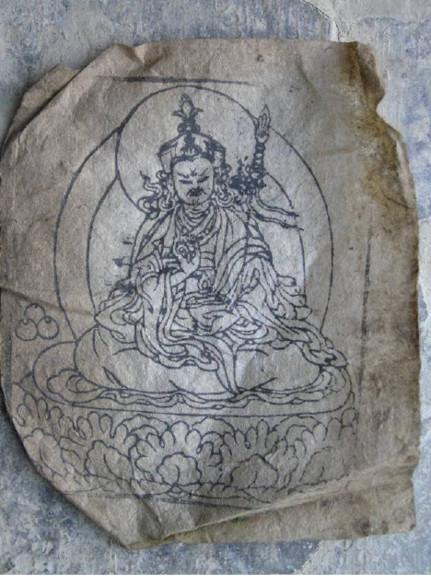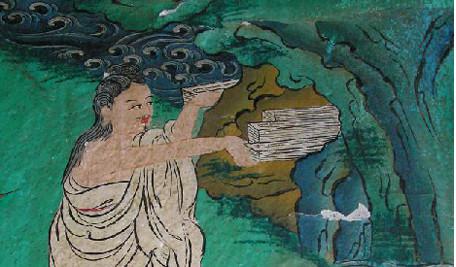A Step Away from Paradise: A Tibetan Lama's Extraordinary Journey to a Land of Immortality (4 page)
Authors: Thomas Shor

The first time I met Kunsang, I asked him the meaning of his father’s name.
Kunsang told me that to understand the name Tulshuk Lingpa we had to go right back to Padmasambhava, the eighth-century visionary and mystic wizard often credited with bringing the dharma, or Buddhist teachings, to Tibet. Padmasambhava established the teachings by travelling through the high central Asian plateau, subduing the local deities belonging to the Bonpo (the indigenous religion of Tibet with strong shamanic elements), and turning them into protectors of the dharma.

Padmasambhava
Kunsang explained that Padmasambhava not only understood the past and had mastery of the present but could see into the future as well. He gave only the teachings that were right for the founding of Buddhism in that remote corner of the world in the eighth century. Other teachings that he knew would be better imparted at a later date, even hundreds or thousands of years later, were hidden by him. These hidden teachings are known in Tibetan as
ter
or terma, which means treasure. Those who find terma are known as
tertons
, treasure revealers.
Padmasambhava hid things like tantric scriptures. He hid certain ritual objects that, once found, would give tremendous powers. He hid great spiritual insights. But most important, Kunsang explained, he hid the secret valleys like the one in Sikkim—Beyul Demoshong. These valleys are Padmasambhava’s most precious treasures, and the most difficult to find. Kunsang was both eloquent and enthusiastic about Padmasambhava’s tremendous insights. Knowing the teachings of the Buddha would become endangered in Tibet, Padmasambhava also knew what would be needed and when. Some of the most important Tibetan Buddhist scriptures were protected over vast expanses of time in the changeless layers of a terton’s consciousness. Terma remains hidden from the world until time itself ripens, until a particular terton takes incarnation and ‘opens’ it.
I told Kunsang I could imagine how Padmasambhava hid a text or even a
dorje
, the two-sided brass implement lamas use in rituals representing the thunderbolt. But when I told him I didn’t understand how an insight could be hidden, especially a spiritual insight, he burst out laughing.
‘You only
imagine
you can understand how Padmasambhava hid his texts! To be sure, he didn’t just take a text and bury it in a cave or stuff it in a crack in a cliff. It wasn’t like that at all.’
He explained how there are five places where Padmasambhava hid his terma. He hid some in the earth, this is known as
sa-ter
; he hid some in the mountains. This is
ri-ter
. Some,
chu-ter
, he hid in water, and yet others are called
nam-ter
. These are the treasures Padmasambhava hid in the sky. Others,
gong-ter
, he hid in the mind itself.
Hiding terma is one thing; finding it, another. As Padmasambhava hid each of the terma, he appointed a newly subdued ‘protector of the dharma’ to guard it and keep it hidden until that particular teaching, powerful object or insight was needed.
At the same time that he was hiding a terma in the world outside, he was also planting it inside, in the mind of one of his disciples. Not on the surface of his mind, the part that changes, that holds memories and is lost from one lifetime to another. He planted the knowledge of the terma in the unchanging layer of his disciple’s mind, where the teaching would be protected.
What happens is this: when the time comes and a particular terma is needed, the right disciple takes an incarnation. He is a bit crazy. He has the ability to enter a mystic state and have revealed to him by a dharma protector or a
dakini
—a female messenger or guide—the teaching or empowerment given directly by Padmasambhava.
When a terton is given a scripture it isn’t actually in the form of a book. Or not at first. Sometimes what the terton has revealed to him is only a few scratches on a stone. Other times he reaches his hand
inside
a stone and pulls out a tightly rolled scrap of yellowed paper. On it will be a few ‘letters’ in an alphabet only a terton can understand. He will then spend hours or even days without sleep, unfolding the meaning contained in those few characters, bringing them down—as Tulshuk Lingpa once said—from the Celestial Language into Tibetan.

A white-robed
terton
in a literal
depiction of the taking out
ter.
Wall painting, Queen of Bhutan’s monastery, Darjeeling
Tulshuk Lingpa was a terton.
Tertons
are known for being crazy—and totally unpredictable. They are famous for being idiosyncratic and irrational, and by their very nature inscrutable. Illogical behavior is their forte. They are expected to act in ways that defy the rationality to which the rest of us are bound. After all they reveal hidden treasures, and because of this they are especially revered among Tibetans and—like precious jewels—they are exceedingly rare. You cannot train to become a terton. You are born with the ability—or not. No amount of study can make you a terton. In fact, too much learning might very well take the ability right out of you. As William Blake wrote in his
The Marriage of Heaven and Hell
: ‘Improvement makes straight roads, but the crooked roads without Improvement, are roads of Genius.’
Kunsang explained that his father’s name was Tulshuk Lingpa.
Lingpas
are like the elites of
tertons
. ‘They find special hidden treasures,’ he said, ‘therefore, they are especially crazy!’
‘And the name Tulshuk,’ I asked. ‘Does that have significance?’
To understand that, Kunsang told me, we have to go back to Golok, north of Kham, in eastern Tibet. That is where his father was born. He was born with the name Senge Dorje, which means Lion Thunderbolt.
From the earliest age, Senge Dorje stood out as a particularly witty, intelligent and mischievous boy. He could learn despite hardly being taught. This made people suspect he was an incarnation, as often happens with boys who show special abilities. At a very early age he was sent to the Domang Gompa, a monastery in his native Golok, to be trained. This must have been in the early- or mid-1920s.
There was a great lama at that monastery known as the Domang Tulku, or reincarnation. That was his title. He was a lama who had taken reincarnation many times at the Domang Gompa, increasing his spiritual insight with each successive incarnation. His name was Dorje Dechen Lingpa. Being a
lingpa
, one of those rare elites of treasure revealers, he had the spark and could recognize it in the boy. He saw the boy’s easy capacity for both learning and mischief. He observed that though he skipped most of his lessons, he earned the jealousy of his classmates by learning and being able to recite the ancient texts with only a single cursory reading. He began to suspect the boy had an extraordinary future ahead of him.
When the boy was at the age of losing his baby teeth, Dorje Dechen Lingpa decided to test him. He took Senge Dorje and half a dozen other young novice monks across the empty plain behind the monastery to where a chain of bare mountains rose abruptly in a series of huge cliffs. Leading them in a single file up the rock face along a treacherous way of loose scree and sheer drops, he brought them to a crack in the cliff that opened to a cave. There he sat in a circle with them in the cave’s twilit interior and took out the implements of a lama’s ritual life: the
dorje
, or double-sided brass implement that represents the thunderbolt; the
damaru
, or handheld drum made from children’s skulls; and the
dilbu
, or ritual bell. Into a small brass bowl he poured a few handfuls of rice from an old leather pouch and placed it in the center of the tight circle in which they sat.
Tibetan lamas chant sacred syllables at such a deep pitch you can feel the empty air between you vibrate. Imagine how much stronger the vibration would be if you’re in a cave and tons of ancient rocks resound. If you’re seven years old and an apprentice, learning both the reality of the Unseen and how to communicate with it, the lama appears to you like a wizard and the beating of his drum is heard in other worlds; then the ringing of his bell calls forth unseen beings. You sit—fear riding up your spine and spilling over into wonder and awe as the atmosphere in the cave concentrates and takes on form.
Dorje Dechen Lingpa performed a ritual that day that moved his young novices to a wide-eyed state of supernatural anticipation. When he had achieved his desired atmosphere, in which what is beyond sense reached the edge of the palpable, he took a handful of rice from the bowl. Intoning a single incantation, followed by a resounding silence, he threw the rice into the air.
In the ensuing silence the children gasped, in both fear and wonder, as the grains of rice turned into
purbas
, the daggers of Tibetan ritual, and danced before them floating and shimmering in the air.
The children all pulled back, faces marked by fear—except for one, Senge Dorje, whose face grew steady. He raised his hand and fixing his eyes on the
purba
closest to him, reached out and with a confidence born out of fearlessness he grasped it and held it fast.
The other children gasped in wonder and admiration at their comrade who had reached into a vision and brought back a piece; Dorje Dechen Lingpa simply smiled.
This is the story as Kunsang told it. Of course neither he nor I was there. Yet as with so many other fantastic stories in this remarkable tale, there is an element of truth in the apparent fantasy, a blurring of the line between fact and fiction out of which something tangible arises as if designed to make us question our assumptions. In this case it was the
purba
itself. For Kunsang told me that his father was to carry that
purba
in a cloth bag or tucked beneath his belt for the rest of his life.
When Kunsang was a young boy of eight or ten years, he used to sneak into his father’s room in the middle of the night with some friends when thunderstorms were coming. Every night his father would stick the
purba
in a bowl of rice beside his bed, and there it would be—in the pitch-dark room—the tip glowing with the coming of the storm, sparking a moment before each bolt of lightning flashed in the sky. His friends would get so scared they’d want to scream and run away. But he’d grab on to them and force them to silence as the
purba
glowed and sparked next to his sleeping father.
The day after Tulshuk Lingpa got the
purba
, Dorje Dechen Lingpa took him on a long walk. ‘I am sorry for taking that
purba
,’ the boy said as soon as they were alone. He thought he was to be reprimanded.
Dorje Dechen Lingpa smiled inwardly.
‘It’s quite all right,’ the lama said. ‘In fact it is very good. Yesterday was a test, and you alone passed it. While I could manifest the
purbas
, even
I
couldn’t have brought one down. The
purba
you brought down was
nam-ter
, sky treasure, treasure hidden long ago in the sky. That you got it means you are a terton. Let me see it.’
